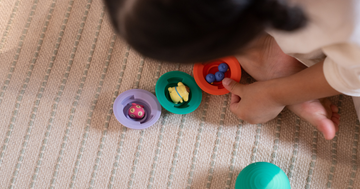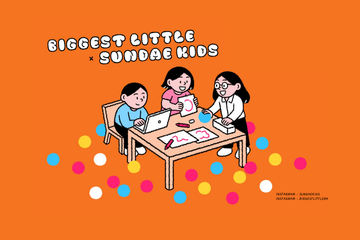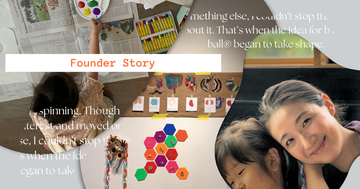Baby-Led Play Is Just as Real as Baby-Led Weaning
When most people hear “baby-led,” their minds likely go straight to the concept of baby-led weaning—the practice of letting your baby feed themselves solid food when they’re ready. It’s become a popular and widely discussed parenting method, encouraging babies to explore new tastes and textures at their own pace. But what if I told you that there’s another “baby-led” practice that is just as crucial to your child’s development, yet often overlooked? Enter baby-led play or child-led play.
What Is Baby-Led Play?
Much like baby-led weaning, baby-led play or child-led play are all about giving your child the freedom to explore and engage with their environment on their own terms. Instead of adults dictating how and what to play, the child’s own curiosity and interests guide the experience. Compared to structured play, it’s a more hands-off approach. Early childhood development insights from Reggio Emilia and Montessori support child-led play in one way or another. For example, Reggio promotes emergent curriculum, where children’s interests dictate the flow of the lesson. This philosophy also extends to playtime, encouraging children to shape their own learning through self-directed discovery.
The Benefits of Baby-Led and Child-Led Play
-
Encourages Independent Thinking and Creativity
When babies and children are given the freedom to choose how to interact with their environment, they develop essential skills like problem-solving, critical thinking, and creativity. Piaget, the renowned developmental psychologist, described children as “little scientists” who learn by interacting with their environment, discovering how things work through trial and error. Similarly, Gopnik, a developmental psychologist at UC Berkeley, suggests that children engage in scientific exploration during play—testing hypotheses, experimenting, and figuring out the world on their own. Baby-led play and child-led play emphasize this natural discovery process, fostering creativity and independent thinking.
-
Promotes Physical Development
Baby-led play and child-led play encourage babies and young children to develop physical skills through exploration. Piaget believed that physical interactions with objects were a critical part of cognitive development, helping children build connections between their actions and the results they observe. By engaging with safe toys and materials, children practice fine and gross motor skills, learning through action. Whether they are stacking blocks, rolling a ball, or crawling after a toy, each of these activities helps them develop strength, coordination, and control.
-
Supports Emotional Development
Both baby-led play and child-led play promote emotional development by encouraging children to play at their own pace and explore their feelings. This method helps children navigate frustration, build resilience, and boost self-esteem. In Reggio Emilia classrooms, children’s ideas and emotions are central to learning, giving them space to express themselves in different ways through the “hundred languages of children.”
How to Encourage Baby-Led and Child-Led Play
So, how can you encourage baby-led play and child-led play at home?
Remember SOFT – Space, Object, Freedom, and Time
Space – Start by providing a safe and calm environment free of distraction and hazards. Reggio Emilia advocates for creating an environment where children are encouraged to explore and interact with things they find intriguing. Whether it’s through simply touching, looking, or more cognitively complex activities like drawing, building, or pretending, the space you provide is essential to encouraging child-led play.
Objects – Safe (depending on their age) open-ended toys, objects, and a variety of materials are your child’s best friend. Simple items like balls, wooden blocks, fabric, or even household objects like cardboard boxes and spoons can be just as engaging as any manufactured toy. We’ll dive deeper into this in here, but think of b is for ball® as an example of a versatile object that invites children to explore and engage creatively.
Freedom – Once you've provided the space and objects, allow your child the freedom to choose what they want to engage with, rather than imposing a strict rule or play schedule. Montessori emphasized the importance of creating a space where children feel empowered to make their own decisions. Freedom is empowering!
Time – Give your child uninterrupted time to explore these objects, in a comfortable space, with the choices they made independently, stepping back and allowing them to figure things out for themselves. RIE also emphasizes that children need time to explore without interruption to their focus. This helps them develop the attention span and problem-solving skills necessary for independent learning.
How to Incorporate b is for ball® for Child-Led Play
6–12 Months
For infants, b is for ball® is perfect for baby-led play, allowing babies to explore at their own pace. During tummy time, place the ball just out of reach to encourage reaching, arm extension, and strengthening. Its soft silicone material is ideal for sensory play, giving babies the opportunity to mouth it, soothe sore gums, and explore its texture. As babies start crawling, the unpredictable rolling of the ball sparks curiosity and encourages movement, letting them decide how to interact with it.
12–24 Months
As toddlers grow, b is for ball® continues to support child-led play by offering a range of movement. Toddlers can chase, kick, or practice throwing and rolling, building coordination and gross motor strength. While you can describe the ball’s features, it’s the child who leads their play. At this stage, toddlers begin experimenting with stacking the ball’s lids and bodies, exploring spatial relationships, balance, and learning about gravity. The ball also invites water play, encouraging independent exploration as toddlers float, squirt, and splash in the water, experimenting with different motions.
2–3 Years
At this stage, toddlers’ imaginations blossom, and b is for ball® becomes a tool for creative play. It can transform into props for pretend play, like a spaceship or treasure chest, or be used as a loose part in construction play. Children decide how they want to incorporate the ball into their games—whether building towers, stacking it, or using it in their imaginative adventures. This encourages problem-solving and creative thinking, allowing children to lead their play.
3–5 Years
Preschoolers thrive on child-led play, and b is for ball® supports this through a variety of activities. It can be added to sensory bins, used as a sound shaker, or incorporated into scent discovery games. The ball also works well in construction and nature play, where children can build collaboratively or use it in outdoor activities like spraying water to draw on the sidewalk or vinegar and baking soda experiments. These activities empower children to lead their own learning, sparking independence, creativity, and exploration as they decide how to engage with the ball and their surroundings.
We believe baby-led play and child-led play are vital for encouraging independence, creativity, and emotional growth in children. By implementing SOFT—providing safe, open-ended objects like b is for ball®, and allowing freedom and time to explore—you give your child the gift of discovering themselves and the world around them at their own pace.
By embracing baby-led play, you are setting the stage for meaningful, growth-focused play experiences that will benefit your child for years to come.




